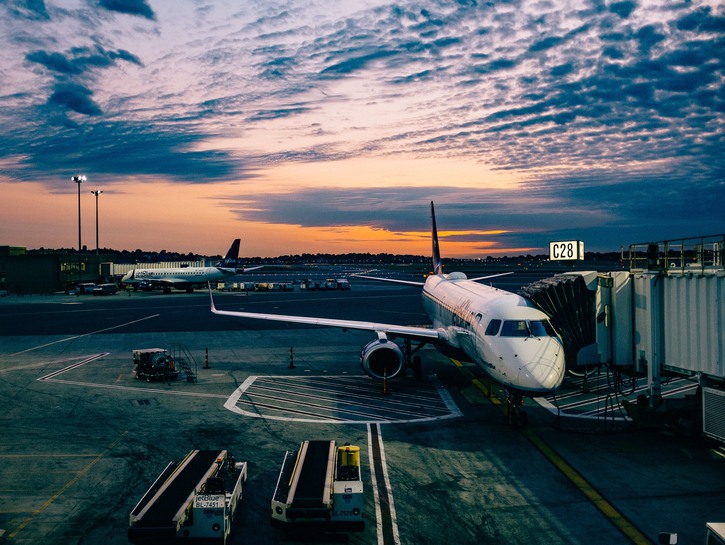
Traveling the world can be life changing, but to truly enjoy the experience, you need to plan effectively.

Videos by TravelAwaits
Keeping your budget intact — and keeping your cool when things don’t work out — will allow you to focus on the adventure.
We asked frequent travelers to share their favorite tips, tricks, and hacks, and the response was overwhelming. Here’s what you need to know before your next trip.
1. Get TSA Pre-Check

The TSA Pre-Check program allows travelers to bypass airport screening lines in favor of an expedited screening. On average, pre-check passengers wait five minutes or less, and more than 200 airports and 65 airlines provide the service.
That doesn’t mean that you’re not screened at all, but the process is much quicker: You don’t need to remove shoes, belts, 3-1-1 liquids, laptops, or light jackets during your screening. $85 buys a five-year program membership.
To qualify, you’ll need to undergo a background check and visit a TSA Pre-Check facility in your area, but frequent travelers say that it’s well worth the hassle.
Traveler Kelsey Dixon tells us, “Waiting in line at the airport is a nightmare without it.”
If the $85 fee seems high, check your credit card agreements. Many travel cards offer a partial or full rebate for the TSA Pre-Check fee, so you might be able to skip the lines without paying a cent.
While we’re on the subject…
2. Use Your Credit Cards

If you’re traveling frequently, credit card rewards programs can help you keep your budget under control. That might sound obvious, but if you haven’t read your membership agreement recently, you might be missing out on some key benefits.
“Frequent flier points from credit card sign-up bonuses and spending fund a large percentage of my trips,” says travel writer Janice S. Lintz. “I received two-million plus points in sign-up bonuses alone and traveled to places like Aruba for less than $1,500. I recently stayed at the Park Hyatt Zanzibar using a combination of points plus money to secure a room for about $114 and earned points at the same time.”
Many travel cards offer access to airport lounges, discounts on tours, and more. If your current cards don’t offer those types of perks, do some research and consider upgrading.
“My favorite [card] is the Chase Sapphire Reserve,” says Dixon. “It’s got a hefty annual fee — $400+ — but you get most of it back in travel credits. I actually now feel like I’m getting ripped off if I pay for a flight full price.”
Chase Sapphire Reserve also provides Priority Pass lounge access, which costs up to $299 on its own. If travel lounges are important to you, it’s a worthwhile perk (and if not, we’ve got a more detailed piece on accessing travel lounges without membership here).
3. Go For Deals, Not Destinations

“Rather than selecting the destination and figuring out what it will cost, look for a bargain,” Lintz suggests. “I traveled to India when I found an outrageous special on jetsetter.com. India suddenly moved to the top of my list. Condé Nast Travelerprofiled my incredible trip on their website.”
“Another time, I flew at the last minute to Korea because again, I found availability on points.” Her conclusion: “Being flexible enables me to be opportunistic.”
Granted, most travelers have certain destinations in mind when they start planning. But if you’re willing to do some extra legwork, you can save a tremendous amount of money.
“Flexibility is the key to traveling inexpensively, so if the flight to your first-choice destination is too expensive, look at other locations nearby,” travel blogger Emily Wilson writes. “You could end up making your trip more exciting by hopping to a few cities.”
4. Break Down Your Flight Prices

Along the same line, if you’re trying to keep your trip within a certain budget, look at the actual amount you’re paying per mile traveled.
“It takes a lot to make up for an expensive flight,” notes Joel McDonald, founder of trip alert service Just Get Out Of Town. “A free room at a resort or a free cruise isn’t much of a bargain if you have to spend $600 per person to get there. But if you find a great deal on a flight and schedule around it, that leaves a lot of room to do whatever you want when it comes to food and lodging.”
McDonald says that the key is watching, waiting, and setting limits to your budget.
“We don’t pay more than 3 or 4 cents per mile to fly anywhere,” he says. “We’ve flown round-trip from Denver to Indianapolis for $29, to Los Angeles for $39, to Raleigh for $84, to Cabo for $110, Aruba for $192. When we can’t find flights under 3 or 4 cents per mile, we use frequent flyer points and fly where we want to go for even less.”
“Simply watch often enough and watch enough destinations, and you’ll have plenty of options to choose from.”
5. Clear Your Cookies When Shopping for Flights

Most websites use cookies, small files that allow the site owner to track visitors and present them with appropriate information. If you search for “trips to India” on a travel site, for instance, you might see articles about Indian cuisine on your next visit.
That’s mostly helpful, but it can also be a disadvantage. If you’re regularly searching for flights to a certain destination, an airline might know that you’re planning the trip — and they won’t see any reason to give you the best possible deal.
Before buying a flight, hotel, or tour, double-check prices by accessing the website with cookies disabled. You can do this easily by opening an incognito window in Google Chrome, or by using private browsing in other browsers.
Here are a few keyboard shortcuts you can use to enable private browsing on various web browsers:
Google Chrome
Windows: Ctrl + Shift + N
Mac: ? + Shift + N
Safari
Mac: ? + Shift + N
Internet Explorer
Windows: Ctrl + Shift + P
It’s a bit of a hassle, but checking prices without cookies has the potential to save you hundreds of dollars.
6. Rethink Your Luggage

Don’t assume that your expensive luggage is ready for the big time. A few inexpensive upgrades can give you peace of mind while traveling.
“The zipper pulls on even the best luggage always get ripped off, as do the fasteners for luggage ID tags,” says Loren Siekman of travel company Pure Adventures. “Ditch them and replace them with cheap metal keychain rings instead. They’re nearly indestructible.”
That’s vital if you aren’t traveling light, but seasoned travelers say that they rarely check bags. James Ian of travelcollecting.com offers this simple hack for saving space in a carry-on:
“I always travel with a suit bag,” he says. “I hang all my pants, shirts and jackets on top of each other on one hanger, then put the single hanger in the suit bag. This is my personal item. It leaves my actual carry-on bag for everything else except clothing, so there is plenty of space. Even better, the folded suit bag usually fits on top of my carry-on bag so that I still have all of the space under the seat in front of me for legroom.”
7. Use Technology To Monitor Your Flight

When you’re traveling, you might want to turn off your electronics and enjoy the moment — and by all means, feel free to unplug once you reach your destination. However, you might want to keep your phone ready at the airport.
“Use an app like FlightAware to get more up-to-date information about your flight than your airline is providing you,” says Richard Pummell of DevelopIntelligence. “By entering your flight information, it will access multiple sources of information to give you updated flight status data and can push this to you to avoid constant checking.”
FlightAware is free for both iOS and Android. Other inexpensive flight-tracking apps include FlightTrack, FlightBoard, and iFly. All offer the same basic functionality, and they’re invaluable tools in certain situations.
“When you’re at the gate and your agent is telling you they either don’t have any information, or that the flight will be departing in 10 minutes — for the third time — it’s frustrating not to be getting accurate information,” Pummell says.
“I was recently on a flight experiencing mechanical issues which delayed takeoff although we had departed the gate. I was able to see way before the airline informed us that our departure time had been pushed out by 90 minutes. Checking the airline’s updated information on their app yielded only the original departure time.”
8. Think About Your Electronics

If you’re planning on using electronic devices on your trip, you’ll need electricity—and that’s not always readily available, especially if you’re on the move.
“Buy a portable phone charger,” says traveling musician Alissa Musto. “There is nothing more stressful than your phone being on 1 percent when you need to access your boarding pass [or] important info on your email, call an Uber, or just use your maps app to find out where you are.”
Of course, you could just buy a phone charger at the airport…but be prepared to pay heavily for the convenience.
“Many airport shops charge $50 for a basic charging cable,” Musto says. “Having a portable charger will be very helpful when you reach your destination as well, especially in Europe where outlets are different from the U.S.”
Outlet adapter kits are fairly cheap, but don’t worry about buying a separate adapter for each of your devices. Instead, pack a thin power strip. You can use it to power all of your devices from a single outlet, and you’ll save a bit of space.
And one more tech tip: If you need to quickly charge your phone, put it on airplane mode. This turns off your phone’s communications, greatly reducing the draw on the device’s battery.
9. Plan For The Worst

If you’re heading out for an international trip, make sure you’ve got copies of all important documents—preferably in a digital format. By scanning your passport and emailing yourself a copy, you can prevent a bad situation from turning truly catastrophic.
“Scan your important documents and keep them on your phone as a locked PDF,” suggests Grainne Kelly, a former travel agent and inventor. “That way, if your ID, passport, travel permission letter, or credit cards get stolen or lost, you’ve got an ‘offline’ place to locate the information.”
“You can also place a copy in your cloud, as long as it is password protected, so that the information is still accessible in the event that your phone is stolen. Just be sure to call the file ‘Aunt Ida’s recipes’ and not ‘All My Important Document Information’!”
While you’re at it, make sure you don’t rely on your phone for crucial information. Get a notecard and write down the numbers for the nearest U.S. embassy or consulate, local English-speaking medical providers, and any other info you might need in an emergency.
Your goal is to have separate paper and digital versions of anything important. That way, if you lose your phone — or if you’re missing something crucial when you’re trying to get somewhere — you’re covered.
10. Use Your Age To Your Advantage

If you qualify for AARP, you can probably enjoy hefty discounts on certain travel-related products and services. AARP membership isn’t exactly expensive (a five-year membership costs about $63), but you don’t have to be a member to enjoy benefits.
“When traveling at age 50 or older, there are some great discounts that are available,” Jenny Smith of the blog How to Move to New Zealand tells us. “These are usually tied to membership with AARP, but some are accessible for anyone who has reached a certain age. These programs allow for discounts on hotel rooms and some tours.”
The AARP offers a Travel Center site with deals on flights, hotels, car rentals, and tour packages. Of course, savvy travelers will still want to check prices carefully.
11. Don’t Pay For Water At The Airport

You can’t bring bottled water through a TSA checkpoint — well, not in any useful quantity, since all liquid quantities are subject to the administration’s liquids rule. That means that you could bring 3.4 ounces of water, which isn’t quite enough to satisfy a thirsty traveler. The good news: There’s an easy workaround.
“Bring an empty water bottle with you through the airport,” Musto says. “It will have to be empty when you go through security, but once you’re through the line, you can avoid overpaying for bottled water at the airport or your hotel by filling your own bottle yourself.”
The TSA approves of this travel tip, noting that it will “save you a few bucks.” That’s putting it lightly: Airport vendors often charge ridiculous rates for water, and given that you can find plenty of water fountains on the concourse, there’s no need to pay those prices.
12. Pack A Luggage Scale (And Ziploc Bags)

“Never travel without a luggage scale,” Kelly says. “Whether you’re buying gifts for family [or] friends, or things for yourself, people love to shop on trips. Having a scale takes the guesswork out of whether or not your bag weighs too much, and whether you should sneak a few things into a family member’s suitcase before you get to the airport.”
The scale can help you avoid a surcharge on some airlines. Kelly also suggests packing disposable plastic bags, which can make a big difference.
“They’re great for keeping all the small things like underwear or phone chargers, and they help to separate leaky or wet items from the rest of your stuff.”
As you travel, you’ll pick up plenty of your own hacks for saving money and avoiding frustration. That’s part of the fun — and skill — of creating memorable travel adventures.


